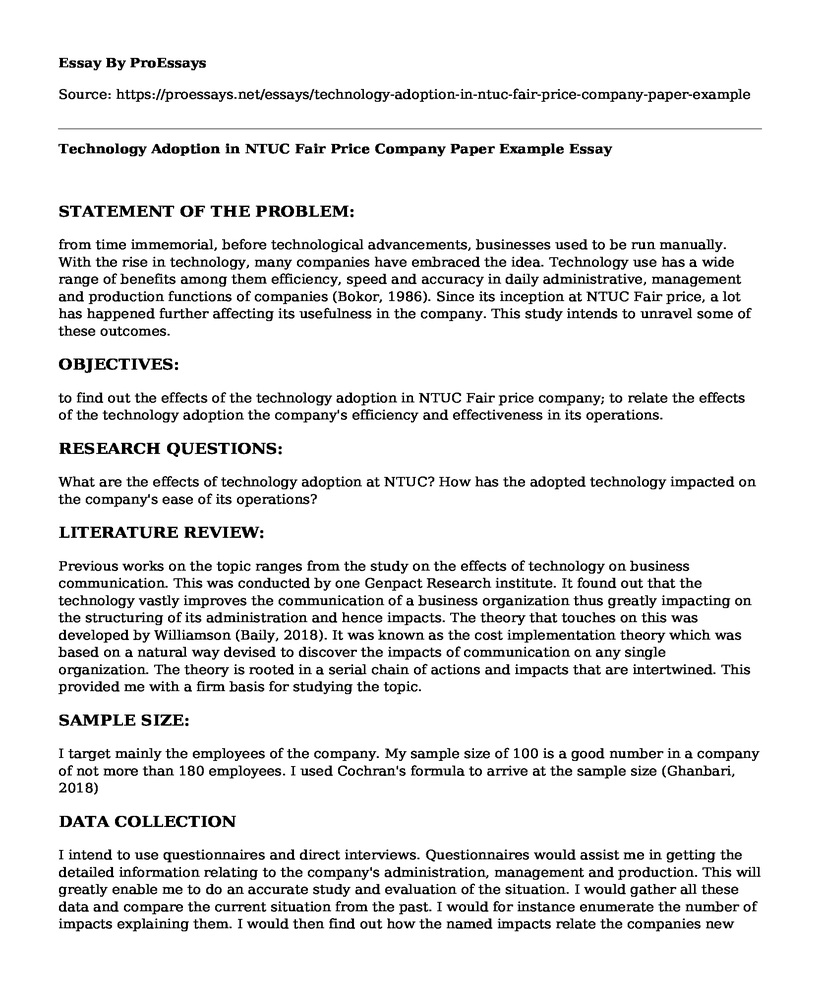STATEMENT OF THE PROBLEM:
from time immemorial, before technological advancements, businesses used to be run manually. With the rise in technology, many companies have embraced the idea. Technology use has a wide range of benefits among them efficiency, speed and accuracy in daily administrative, management and production functions of companies (Bokor, 1986). Since its inception at NTUC Fair price, a lot has happened further affecting its usefulness in the company. This study intends to unravel some of these outcomes.
OBJECTIVES:
to find out the effects of the technology adoption in NTUC Fair price company; to relate the effects of the technology adoption the company's efficiency and effectiveness in its operations.
RESEARCH QUESTIONS:
What are the effects of technology adoption at NTUC? How has the adopted technology impacted on the company's ease of its operations?
LITERATURE REVIEW:
Previous works on the topic ranges from the study on the effects of technology on business communication. This was conducted by one Genpact Research institute. It found out that the technology vastly improves the communication of a business organization thus greatly impacting on the structuring of its administration and hence impacts. The theory that touches on this was developed by Williamson (Baily, 2018). It was known as the cost implementation theory which was based on a natural way devised to discover the impacts of communication on any single organization. The theory is rooted in a serial chain of actions and impacts that are intertwined. This provided me with a firm basis for studying the topic.
SAMPLE SIZE:
I target mainly the employees of the company. My sample size of 100 is a good number in a company of not more than 180 employees. I used Cochran's formula to arrive at the sample size (Ghanbari, 2018)
DATA COLLECTION
I intend to use questionnaires and direct interviews. Questionnaires would assist me in getting the detailed information relating to the company's administration, management and production. This will greatly enable me to do an accurate study and evaluation of the situation. I would gather all these data and compare the current situation from the past. I would for instance enumerate the number of impacts explaining them. I would then find out how the named impacts relate the companies new developments in line with production. Did production improve or reduce after technology adoption? How about the units produced per hour, day, weak and month or year? I would use production and efficiency ratios to arrive at this.
Direct interviews would enable me to to have the light information about the employees, the company and the study topic (Nardi, 2018). This would be the best way to get information from people working in the open spaces probably fields or open office set up. I would use this to administer less involving questions like time of one's service in the institution without getting down into more specific details of the company. This will help save on the shy employees as well. They can possibly hide some important information relating to my study and hence compromising the whole process. My diversity in method collection will therefore get me the required turning point in data collection.
DATA ANALYSIS:
I intend to use a solitary quantitative data analysis method. This will enable me to achieve objective one and two adequately (Nardi, 2018). I would analyze my data with the aid of measures of central tendencies (frequency tables, histograms, means, modes, percentiles and quartiles). From these, I shall have achieved my objective one and two respectively.
References
Bailey, D. H., Duncan, G. J., Watts, T., Clements, D. H., & Sarama, J. (2018). Risky business: Correlation and causation in longitudinal studies of skill development. American Psychologist, 73(1), 81.
Bakos, J. Y., & Treacy, M. E. (1986). Information technology and corporate strategy: a research perspective. MIS quarterly, 107-119.
Ghanbari, Y. (2018). Explaining the components of satisfaction with the quality of life and the sense of place of belonging (Case Study: KhosrowAbad village-Kuhdasht county). Journal of Research and Rural Planning, 5(4).
Kumar, P. (2018). Research Proposal and Literature Review. Academic Discourse, 7(1), 52-56.
Nardi, P. M. (2018). Doing survey research: A guide to quantitative methods. Routledge.
Cite this page
Technology Adoption in NTUC Fair Price Company Paper Example. (2022, Jul 15). Retrieved from https://proessays.net/essays/technology-adoption-in-ntuc-fair-price-company-paper-example
If you are the original author of this essay and no longer wish to have it published on the ProEssays website, please click below to request its removal:
- Business Ethics and Corporate Social Responsibility in Apple
- CEMEX Strategies Before and After the Great Recession
- Paper Example on Enterprise Resource Planning
- Essay Sample on Supporting People With Exceptionalities: The Need for Patience
- Essay on President Shepherd's Inspiring Speech: An Example of Character and Leadership
- Essay Example on Agency Theory: Explaining the Relationships Between Parties
- Paper Example on Exploring Subway's Value Chain: SWOT Analysis







